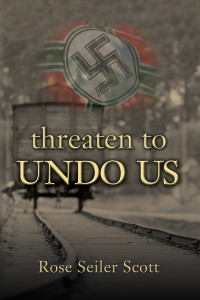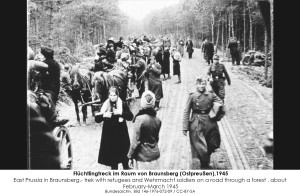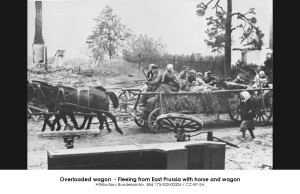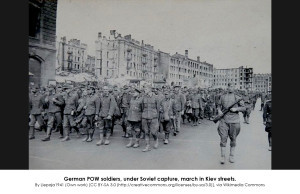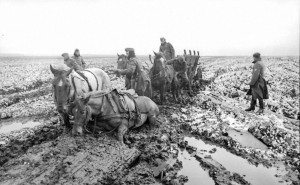Rose Seiler Scott's Blog, page 4
May 29, 2015
Liberators or Captors
Attribution: By János Balázs from Berlin, Deutschland (memorial concentration camp sachsenhausen) [CC BY-SA 2.0 (http://creativecommons.org/licenses/b...)], via Wikimedia Commons
…the train pulled up to another prison camp surrounded with barbed wire. A wrought iron sign at the gate stated “Arbeit Macht Frei.”Liesel was dismayed. This again? She thought of Michal. His family had not been made free by work; she had not been made free by work. Freedom was only at the whim of the authorities and the only thing that would make her free was patience. Maybe. p. 343 Threaten to Undo Us
During the late 1930’s and throughout the Second World War, millions of people, mostly Jews, lost their lives at the concentration camps of Auschwitz, Sachsenhausen, Potulice and other infamous locales. What is not so well known, is that after the war, a number of these camps were re-opened by the Office of State Security under the administration of Polish communists. Ethnic Germans in Soviet controlled Poland and other Eastern European countries were detained and mistreated in these camps, along with anyone remotely suspected of subversive activities against the new regime.
More info: John Sacks, “An Eye for An Eye,”
Alfred deZayas, “A Terrible Revenge”
The post Liberators or Captors appeared first on Rose Seiler Scott.
May 13, 2015
Book Review: Consider the Sunflowers
Tina’s dilemma is whether to marry stable but dull Roland or free spirited Frank, a man w ho wears his with Gypsy blood and dubious faith on his sleeve. Then there is Victor, from Vancouver. Flighty Tina strings them all along. Just as she makes up her mind, along comes Dorrie Harms with her designs on Tina’s intended.
ho wears his with Gypsy blood and dubious faith on his sleeve. Then there is Victor, from Vancouver. Flighty Tina strings them all along. Just as she makes up her mind, along comes Dorrie Harms with her designs on Tina’s intended.
Marriage, Tina discovers is not all sunshine and sunflowers. Realities of life on the prairies, personal tragedy, health issues and her husband’s quick temper coupled with Tina’s own poor choices make marriage and life a struggle. Her Mennonite faith is tested and found wanting.
Schemenauer’s vivid prose brings to life a vivid patchwork quilt of characters and a realistic setting. The reader will root for Tina, the main character, not because she is completely righteous—she is not, but because we want her to make wise choices.
Schemenauer does an excellent job of revealing her characters’ minds; it’s not always pretty and charitable thoughts either- jealousy, anger, prejudice and an endless go around of justifying decisions.
Though the plot seems to veer off a little, the story avoids a formulaic approach. Twists, turns and the characters’ quirks keep the reader turning the pages until the end.
Played out against the backdrop of World War Two,Consider the Sunflowers is a historical romance: a tale of marriage, life and faith.
Consider the Sunflowers is a delightful read, full of all the snippets of Mennonite and agricultural life that only an “insider” could know.
Consider the Sunflowers is 299 pages, $19.95 paperback, publisher Borealis Press of Ottawa, ISBN 978-0-88887-575-4. If you order it through a bookstore or library, you may not need to pay for shipping. You can also order online from Chapters Indigo, http://tinyurl.com/nsylp5j . [No shipping charge on orders of $25 or more in Canada. They also send to other countries but charge for shipping]. Or order from Borealis Press, http://tinyurl.com/lfdo9pf . E-book coming in 2015. For more information, please see http://elmams.wix.com/sflwrs .
The post Book Review: Consider the Sunflowers appeared first on Rose Seiler Scott.
April 24, 2015
The Big Three
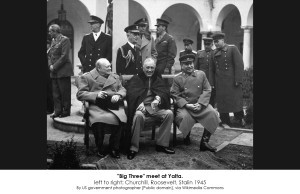
Stalin traced his finger along the Curzon line which encompassed the cities of Brest and Lwów. Regarding the other world leaders with a steely gaze, he squared his shoulders so that his epaulets formed a straight and rigid line. “I will settle for the Eastern territories and nothing less.”
All of those present knew that the co-operation of the Soviet forces, allied with the Western powers, had been critical in turning the tide against Nazi Germany.
Churchill tightened his jowls around his cigar. He was not comfortable conceding anything to Stalin and even viewed Roosevelt with some distrust.
Roosevelt flicked the ashes from his cigarette into the ashtray and coughed; a sound that rattled from deep within his chest. He pulled the matchbox towards himself and looked up, his pale face thoughtful. Shaking out a number of matches, he arranged them on the map…p.viii
In 1945 the World Leaders met at the conferences of Yalta and Potsdam. Among other decisions to be made was what to do with Poland. Stalin had his own ideas, which resulted in the Soviet domination of Eastern Europe for almost 50 years. But re-drawing of the map of Europe resulted in the prolonging of wartime conditions and more suffering and bloodshed than the Western leaders could have realized.
“Threaten to Undo Us” is an historical novel based on the real life story of a family torn asunder by two powerful regimes. Liesel and her children suffer displacement and cruel punishment. She wants her family to be safe and together, but is there any hope in a world turned upside down?
Available May 1st 2015. Threaten to Undo Us is 327 pages, trade paperback, publisher Promontory Press of Victoria, BC, ISBN 978-1-927559-68-0. Order Online through: Promontory Press http://goo.gl/1TmBDv Chapters-Indigo http://goo.gl/z0rFzo Amazon.ca http://goo.gl/4k4AGv Amazon.com http://goo.gl/FlsbZs
The post The Big Three appeared first on Rose Seiler Scott.
April 14, 2015
Flight and Expulsion of Ethnic Germans
It was not quite dawn as they turned onto the road headed southwest…towards the river Oder which had frozen over this winter. An endless caravan of people were fleeing their homes in hopes of crossing into German-held territory, away from the advancing Red Army. Silhouetted against the bleak sky were covered wagons, carts and wheelbarrows loaded up with bundles and furniture piled so high they looked like they might topple. Oxen and horses strained at their load. Animals led by rope and halter bleated, brayed and squawked as they were pulled reluctantly along. p. 152 “Threaten to Undo Us”
After the massacre of German civilians by Soviet forces at Nemmersdorf in October of 1944 many Germans fled west, towards the other Allied Powers. Those who stayed in their homes and farms, waiting for official word from the German army, often found it was too late. In January and February of 1945, civilians, mainly women and children fled in panic towards the Oder-Neisse line, which Stalin had already determined would become the new border between Poland and Germany. When the Red Army caught up with them terror reigned. Wagon treks were machine gunned and plundered and women of all ages were routinely raped.
The post Flight and Expulsion of Ethnic Germans appeared first on Rose Seiler Scott.
April 4, 2015
Wehrmacht on Parade
When they reached Kiev, its citizens watched as thousands of prisoners marched in columns, behind trucks mounted with loudspeakers and Soviet flags. Guards on horseback guarded the flanks of the bizarre parade, but it did not stop men, faint from hunger and exhaustion, from collapsing in the street.
Every bone in Ernst’s ankles pressed painfully onto the fallen arches of his foot. Each step was agony, but he knew that to stop marching, to fall over, was certain death. (p.183 “Threaten to Undo Us”)
Of approximately three million German soldiers captured by Soviet Russia, it is estimated that over one million never returned home. The POW’s were rarely afforded appropriate provisions, shelter or medical treatment, but suffered appalling conditions as they fulfilled war reparations to rebuild the Soviet Union.
In 1956, the last prisoners were repatriated.
For more info: http://en.wikipedia.org/wiki/German_prisoners_of_war_in_the_Soviet_Union
The post Wehrmacht on Parade appeared first on Rose Seiler Scott.
March 27, 2015
Wehrmacht Army in Russia 1941
Caught in a deep rut, they dug the wheels of the wagon out only to sink again a few metres later.
Halfway back to the base, the horses collapsed.
The sight of their frothy mouths and quivering ribs made Ernst feel ill. “Take off their harnesses,” he ordered Horst.
“Blitzkrieg,” a lightening war was what Hitler called it and with General Guderian’s plans utilizing modern weaponry, there was every reason to think Operation Barbarossa, the invasion of the Soviet Union would be successful for the German Reich. But as the average Wehrmacht soldier was to discover, the plan did not account for the Russian landscape or ferocious winter climate, in which their machinery became largely useless. Just outside of Moscow, the campaign stalled and the Red Army was able to mount an offensive, considered to be the turning point of the Second World War.
Photo: Sowjetunion-Mitte (Kursk).- Pferdegespann in tiefem Schlamm eingesunken; PK 698 Bundesarchiv, Bild 101I-289-1091-26 / Dinstühler / CC-BY-SACaught i
The post Wehrmacht Army in Russia 1941 appeared first on Rose Seiler Scott.
March 20, 2015
Łódź to Litzmannstadt
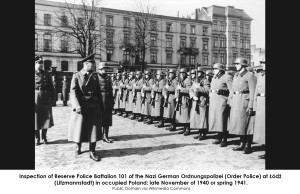
“I’m out of sugar,” said Liesel. Usually she would have just gone to the neighbor, old Pani Zawadski,.. “I was going next door to borrow some.”
Ernst shook his head. “You can’t,” he said. “I am on patrol and I cannot be seen to be associating with the enemy in any way. And that means you cannot mix with any of the Poles either.”
Ernst had said little about what he was doing. Some sort of police work Liesel assumed. She did not really want to know, but her life had definitely changed. She thought about all the ways that their lives had intersected with those around them. The neighbors, the hired help, and the shops in Łódź that she had frequented.
Shopping had become an annoyance. Many of the stores she used to patronize were off limits now, as Germans could not be seen at Jewish establishments without repercussions. Furthermore, since the occupation, they were calling Łódź “Litzmannstadt” after some important Nazi General. The Nazis had renamed so many streets, it was confusing to get around the city. p.83 Threaten to Undo Us.
Historical note:
The city of Łódź was occupied in September 1939 by the German army and shortly thereafter, renamed “Litzmannstadt” after Karl Litzmann, the German general who had captured the city in the Great War. Infamously, Łódź was the site of one the largest Jewish ghettos, before the inhabitants were taken to concentration camps. In 1945, with the occupation of the Soviets, the city became part of the “People’s Republic of Poland.”
The post Łódź to Litzmannstadt appeared first on Rose Seiler Scott.
March 12, 2015
A Hitler Youth Parade
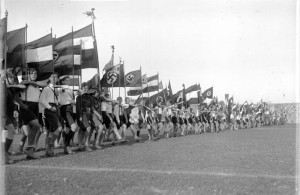
Bundesarchiv, Bild 102-14983 / CC-BY-SA [CC BY-SA 3.0 de (http://creativecommons.org/licenses/b...)], via Wikimedia Commons
The Jungvolk leader’s voice echoed across the Platz. “As you march in step, you will be trained to be a National Socialist faithful to your duty and great future before us! The Fuhrer expects your service, loyalty and duty. Ten year old cubs and little maids, you are not too young to be a comrade in this glorious community. Kurt perked up at this. Soon he could join the “Jungvolk,” march in the parade and practice the drills. He could hardly wait to wear the uniform and sing the patriotic songs.” p. 124 Threaten to Undo Us
The Hitler Youth (Hitler Jugend), the youth branch of the National Socialist party had its earliest origins in the 1920’s and by 1933 was the only “official” youth organization in Germany.
Adolf Hitler had no qualms about using the next generation to further the ideology of National Socialism and children were attracted to the scout-like program with its competitions, skills training, parades and outdoor adventures. But even if they didn’t want to be in the Hitler Youth or the League of German girls, it was soon not much of a choice as on Saturdays children could attend the Hitler Youth or go to school instead. (Social Education/ October 1983 p. 394).
Nazism and traditional Christian beliefs were not compatible and Hitler Youth activities subtly drew children away from religious observance. Schoolteachers and Jungvolk leaders had kowtowed early on with Hitler’s new educational curriculum of racial superiority and German nationalism. Hitler youth activities were scheduled on Sundays, and at summer camps children were taught the uselessness of religious faith, repeating little ditties such as, “we are the rollicking Hitler Youth, we have no need of Christian truth…” http://histclo.com/youth/youth/org/nat/hitler/act/rel/hya-rel.htm Religious rites of passage, such as confirmation were replaced by Nazi ceremonies. http://research.calvin.edu/german-propaganda-archive/jufeier.htm By the time most German children reached adulthood, Nazi ideals were already part of their psyche.
More info: http://www.historyplace.com/worldwar2/hitleryouth/hj-road.htm
As a lead up to the release of my novel “Threaten to Undo Us,” I am posting historical photos, with an excerpt from my book and a little snippet of history. Enjoy! Threaten to Undo Us can be pre-ordered at www.promontorypress.com. Use code “SpringPreOrder” to get 20% off the cover price.
The post A Hitler Youth Parade appeared first on Rose Seiler Scott.

![Attribution: By János Balázs from Berlin, Deutschland (memorial concentration camp sachsenhausen) [CC BY-SA 2.0 (http://creativecommons.org/licenses/by-sa/2.0)], via Wikimedia Commons](https://i.gr-assets.com/images/S/compressed.photo.goodreads.com/hostedimages/1437020707i/15528737._SY540_.jpg)
